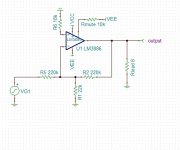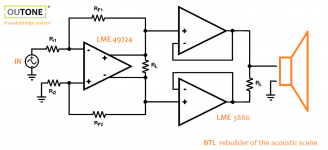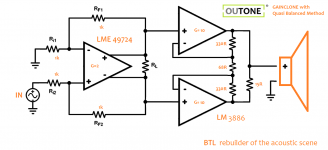Apex has such a thing but I don't think you want to know how much it cost !
https://www.apexanalog.com/apex-products/pa50/
https://www.apexanalog.com/apex-products/pa50/
See the unity gain chipamps here:

http://www.diyaudio.com/forums/chip-amps/250263-improving-lm3886-amplifier-21.html#post4167380
http://www.diyaudio.com/forums/chip-amps/250263-improving-lm3886-amplifier-22.html#post4167711

Or better perhaps, the TDA7293/4 has a pre gain stage that then connects, through external connection, to the power buffer stage. I wanted to try this but I remember some issues ...
Cheers

http://www.diyaudio.com/forums/chip-amps/250263-improving-lm3886-amplifier-21.html#post4167380
http://www.diyaudio.com/forums/chip-amps/250263-improving-lm3886-amplifier-22.html#post4167711
Or better perhaps, the TDA7293/4 has a pre gain stage that then connects, through external connection, to the power buffer stage. I wanted to try this but I remember some issues ...
Cheers
Last edited:
The circuit in Post #5 reduces the overall loop gain to make the amplifier stable. While that certainly is a valid approach, you'll get much better performance by using noise gain compensation. NG compensation allows you to maximize the loop gain at LF while rolling it off beyond some cutoff frequency. All that's required is an RC circuit between the inverting and non-inverting inputs of the opamp/LM3886.
~Tom
~Tom
Um... You may want to re-think that 15 ohm on the output.
Here's a good app note on op-amp compensation: http://www.ti.com/lit/an/sboa015/sboa015.pdf
~Tom
Here's a good app note on op-amp compensation: http://www.ti.com/lit/an/sboa015/sboa015.pdf
~Tom
Bridged is much better to parallel.
I'd say each has its own advantages. Bridge offers more power, but each amp half needs to be designed for half the load impedance (--> bigger heat sink, higher output current needed). Parallel offers twice the output current and the ability to drive low load impedances, but does not increase the output power. If you want the benefits of both, go with a bridge+parallel solution...
Tradeoffs, tradeoffs...
~Tom
Great care with parallel has to be taken to match output resistors.
Also the same goes for gain resistors.
If there is even a small difference the amplifiers can start fighting each other.
If somehow one amp gets a glitch and the other doesn't they can again fight each other.
Also the same goes for gain resistors.
If there is even a small difference the amplifiers can start fighting each other.
If somehow one amp gets a glitch and the other doesn't they can again fight each other.
I'm thinking the OP needs more education than a simple bridged vs. parallel discussion.Bridged is much better to parallel.
Put output1 to one side of speaker and output 2 to other side of speaker.
No 15 ohm resistor required.
Have both LM3886 none inverting.
given that single chip amps are designed for pretty standard consumer loudspeakers you really need to parallel when you bridge
unless you are driving your own creation with say individually amped drivers then you can match chip amp I, V capability more closely to the better known load, say 4 Ohm woofer vs 16 Ohm CD
unless you are driving your own creation with say individually amped drivers then you can match chip amp I, V capability more closely to the better known load, say 4 Ohm woofer vs 16 Ohm CD
not really, an 8 ohm speaker is safe to drive from bridged lm3886, at+-28 V rails.
no different than 4 ohm load with a single lm3886 and +-28 v rails.
16 ohm is absolutely okay with bridged config, at +-35 v rails.
yeeehaa starts when you have a 2 ohm speaker...
then paralell will be a logical choice, question is why would you have a 2 ohm speaker at all.
OR, if you plan on using +-35 rails and drive a 4 ohm load. then parlelling is a good idea.
or if you need more juice, then go BPA. witch is btw totally pointless with lm3886.
simply choose a different IC that suits the job better.
no different than 4 ohm load with a single lm3886 and +-28 v rails.
16 ohm is absolutely okay with bridged config, at +-35 v rails.
yeeehaa starts when you have a 2 ohm speaker...
then paralell will be a logical choice, question is why would you have a 2 ohm speaker at all.
OR, if you plan on using +-35 rails and drive a 4 ohm load. then parlelling is a good idea.
or if you need more juice, then go BPA. witch is btw totally pointless with lm3886.
simply choose a different IC that suits the job better.
single drivers aren't so bad as loads - but dynamic systems aren't limited to simple I=V/R
certain patterns of signal - essentially "pumping" a resonance then reversing the phase can draw more current than the voice coil R would lead you to believe - 2x is a minimum factor for dynamic current peaking
that makes a 3886 "4 Ohm" drive spec really mean its just barely competent for a 8 Ohm nominal dynamic driver directly driven
multiway speakers can have poor crossover designs that make the problem much worse Self, Crodell's Books both cite large worst case overcurrent demands of >5x the loudspeaker's "nameplate" impedance
certain patterns of signal - essentially "pumping" a resonance then reversing the phase can draw more current than the voice coil R would lead you to believe - 2x is a minimum factor for dynamic current peaking
that makes a 3886 "4 Ohm" drive spec really mean its just barely competent for a 8 Ohm nominal dynamic driver directly driven
multiway speakers can have poor crossover designs that make the problem much worse Self, Crodell's Books both cite large worst case overcurrent demands of >5x the loudspeaker's "nameplate" impedance
Last edited:
This Forum has a post with a link to a (three different) speakers test that showed more than 5times the current passing to the reactive speaker load than what the rated speaker impedance would indicate for a resistor/dummy load.............multiway speakers can have poor crossover designs that make the problem much worse Self, Crodell's Books both cite large worst case overcurrent demands of >5x the loudspeaker's "nameplate" impedance
Reading that test report made me change MY design procedure from allowing double the output current to triple the output current.
i.e. a 100W into 8ohms meeds to drive 40Vpk and 5Apk into a 8r0 resistive load AND must be able to drive 15Apk into a reactive load, without the PSU or the amplifier collapsing.
i.e. a 100W into 8ohms meeds to drive 40Vpk and 5Apk into a 8r0 resistive load AND must be able to drive 15Apk into a reactive load, without the PSU or the amplifier collapsing.
How long would this peak power requirement take (current pulse width)?
- Status
- This old topic is closed. If you want to reopen this topic, contact a moderator using the "Report Post" button.
- Home
- Amplifiers
- Chip Amps
- LM3886 AS POWER BUFFER


